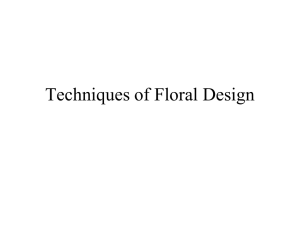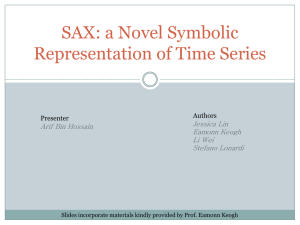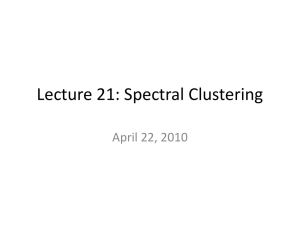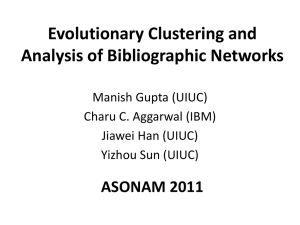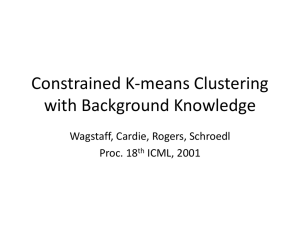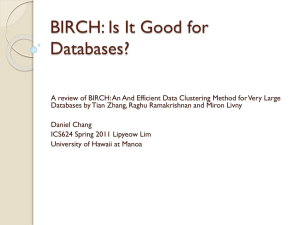Clustering - Microsoft Research
advertisement
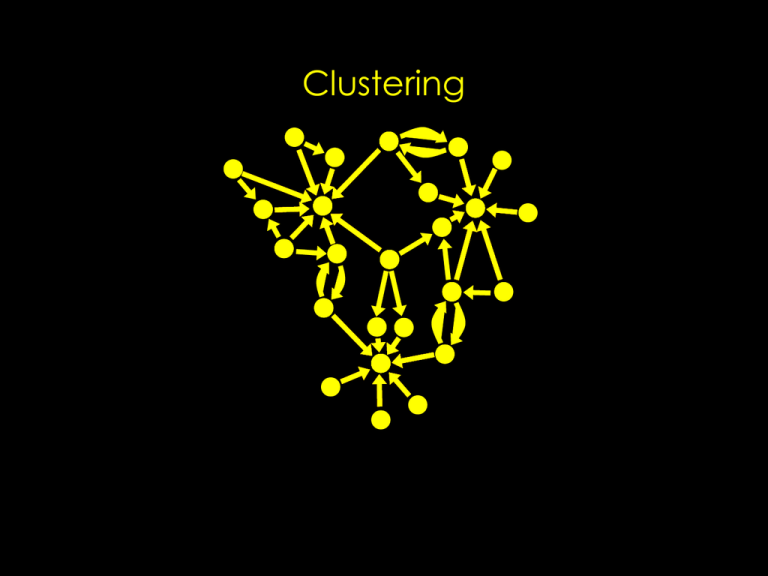
Clustering How are we doing on the pass sequence? Pretty good! We can now automatically learn the features needed to track both people Same set of weights used for all hidden units But, it sucks that we need to hand-label the coordinates of both men in 30 frames and handlabel the 2 classes for the white-shirt tracker Unsupervised learning • Goal: Learn a machine or model that explains the data using a predefined set of assumptions about how the explanations can work • There isn’t any labeled data, just input patterns (ie, instead of x,t-pairs, we have only x’s) • Examples of unsupervised learning – – – – Clustering (eg, k-means clustering) Dimensionality reduction (eg, PCA) Data compression methods (eg, ZIP, JPEG, MPEG) Generative models & Bayesian networks (tomorrow) A simple example of unsupervised learning • Our explanation of the data is that each training case is equal to an unknown number m plus zero-mean Gaussian noise with unknown variance s2 • Unsupervised learning – Determine m and s2, and – For each training case, determine the noise signal Noise signal for training case xn A simple example of unsupervised learning • What can this model be used for? • Outlier detection / novelty detection – Given a new input xN+1, define p as follows (see figure) If xN+1 < m let p = z=-∞ N+1 N(z|m,s2)dz and otherwise ∞ let p = z=xN+1 N(z|m,s2)dz x – Then, we can say that the new input xN+1 is an outlier (“unusual”) if p < 0.01 • Preference prediction – Given a set of new inputs, we can rank them according to probability xN+1 Problem Gaussian estimated from training data Training data This test case has higher density than any of the training cases, but is quite probably an outlier K-means clustering Data and initial (random) means Assign each point to its Set each mean to the nearest mean average of its data Iteration 1 Iteration 2 Iteration 3 Iteration 4 and convergence K-means clustering • Suppose x1,…,xN are real-valued or vector-valued • Goal: Learn K means and assign each training case to a mean • Denote the means by m1,…, mK • Use one-of-K encoding for the assignments: rnk = 1 if xn is assigned to mk, and rnk = 0 otherwise • The goal of k-means clustering is to find the r’s and m’s that minimize the following cost function: • Generally, finding an exact solution takes time that is exponential in N K-means clustering • Note that given the m’s we can efficiently find the best r’s, and given the r’s, we can efficiently find the best m’s • Here’s the algorithm: Pick initial means randomly or cleverly Loop until convergence – Assign each training case to its nearest mean: – Set each mean to the average of its training cases: • Each step minimizes J wrt the r’s or the m’s, but the procedure is not guaranteed to find the minimum of J Example Data and initial (random) means Assign each point to its Set each mean to the nearest mean average of its data Iteration 1 Iteration 2 Iteration 3 Iteration 4 and convergence Iteration Example: Color quantization • Consider each image pixel as a 3-D vector (RGB) and use K-means clustering to find K “prototype colors” • Now, each pixel in the image can be stored using log2(K) bits, with some loss in color quality 24 bits per pixel 1 bit per pixel 1.6 bits per pixel 3.3 bits per pixel EM for a mixture of Gaussians • Initialization: Pick m’s, S’s, p ’s randomly but validly • E Step: For each training case, we need q(z) = p(z|x) = p(x|z)p(z) / (Sz p(x|z)p(z)) Defining = q(znk=1), we need to actually compute: Do it in the log-domain! • M Step: Recall: For labeled data, g(znk)=znk EM for mixture of Gaussians: E step p1= 0.5, m1= F1 = p 2= 0.5, m 2= F 2= c z Images from data set EM for mixture of Gaussians: E step P(c|z) p1= 0.5, m1= F1 = c p 2= 0.5, m 2= F 2= c =1 0.52 =2 0.48 c z Images from data set = EM for mixture of Gaussians: E step P(c|z) p1= 0.5, m1= F1 = c p 2= 0.5, m 2= F 2= c =1 0.51 =2 0.49 c z Images from data set = EM for mixture of Gaussians: E step P(c|z) p1= 0.5, m1= F1 = c p 2= 0.5, m 2= F 2= c =1 0.48 =2 0.52 c z Images from data set = EM for mixture of Gaussians: E step P(c|z) p1= 0.5, m1= F1 = c p 2= 0.5, m 2= F 2= c =1 0.43 =2 0.57 c z Images from data set = EM for mixture of Gaussians: M step p1= 0.5, m1= F1 = p 2= 0.5, m 2= F 2= 1 to the average of zP(c=1|z) Set m 2 to the average of zP(c=2|z) Set m c z EM for mixture of Gaussians: M step p1= 0.5, m1= F1 = p 2= 0.5, m 2= F 2= 1 to the average of zP(c=1|z) Set m 2 to the average of zP(c=2|z) Set m c z EM for mixture of Gaussians: M step p1= 0.5, m1= F1 = p 2= 0.5, m 2= F 2= Set F 1 to the average of diag((z-m ) (z-m ))P(c=1|z) 1 1 T Set F 2 to the average of diag((z-m ) (z-m ))P(c=2|z) 2 2 T c z EM for mixture of Gaussians: M step p1= 0.5, m1= F1 = p 2= 0.5, m 2= F 2= Set F 1 to the average of diag((z-m ) (z-m ))P(c=1|z) 1 1 T Set F 2 to the average of diag((z-m ) (z-m ))P(c=2|z) 2 2 T c z … after iterating to convergence: p1= 0.6, m1= F1 = p 2= 0.4, m 2= F 2= c z Non-vector-space clustering For K-means clustering and EM, • The data must lie in a vector space, where Euclidean distance is a natural measure of similarity – Some methods (such as mixtures of Gaussians) allow each cluster to stretch and rotate its data, but these methods are still essentially based on Euclidean distance • There can be advantages to using kernels k(xi,xk) to measure similarity and then making predictions using training cases • Now, we will study this approach for clustering, using s(i,k) to denote the similarity of xi to xk (these are like kernels, but not necessarily formally the same) K-centers clustering (aka K-medoids clustering and K-medians clustering) K-centers clustering (aka K-medoids clustering and K-medians clustering) Randomly choose initial exemplars, (data centers) K-centers clustering (aka K-medoids clustering and K-medians clustering) Assign data points to nearest centers K-centers clustering (aka K-medoids clustering and K-medians clustering) For each cluster, pick best new center K-centers clustering (aka K-medoids clustering and K-medians clustering) For each cluster, pick best new center K-centers clustering (aka K-medoids clustering and K-medians clustering) Assign data points to nearest centers K-centers clustering (aka K-medoids clustering and K-medians clustering) Assign data points to nearest centers Convergence: Final set of exemplars (centers) The K-centers clustering algorithm • Denote the index of the center that xi is currently assigned to by ci (ci = i indicates that xi is a center) • Initialization: Randomly pick K points and set ck = k • Loop until convergence – For all i s.t. ci i set ci = argmaxk:c k=k – For all k s.t. ck = k s(i,k) • Compute k new = argmaxi:c =k (Sj:c =k s(j,i)) i • For all i s.t. ci = k set ci = k new j • This is similar to K-means clustering, except that the means are always data points Handwritten digit clustering and recognition Example: Clustering 3000 Buffalo digits Similarity: s(i,k) = - || xi - xk ||2 K=10 K=20 K=40 K=80 The effect of random initialization Affinity propagation Squared error k-centers clustering How good is the solution? Solution that minimizes distances Affinity propagation (Frey & Dueck, Science, Feb 2007) ITERATION # 0 ITERATION #15 # 8 1 ITERATION # #10 #11 #12 #13 #14 9 1 2 3 4 5 6 7 0 0 non-exemplar -5 -5 -5 -5 00 +5 +5 +5 +5 exemplar Affinity propagation Affinity propagation ITERATION #15 +5 0 -5 -5 0 non-exemplar +5 exemplar Solution that minimizes distances How does affinity propagation work? • The sum-product or max-sum algorithms (loopy belief propagation) can be used to approximately maximize the k-centers objective function (more on this tomorrow) • Result – Affinity Propagation: Data points exchange ‘responsibilities’ and ‘availabilities’ Sending responsibilities Candidate exemplar k r(i,k) Competing candidate exemplar k’ a(i,k’) Data instance i Sending availabilities Candidate exemplar k r(i’,k) a(i,k) Supporting data instance i’ Data instance i Sending responsibilities Candidate exemplar k Competing candidate exemplar k’ r(i,k) a(i,k’) Data instance i Sending availabilities Candidate exemplar k r(i’,k) a(i,k) Supporting data instance i’ Data instance i Making decisions: Message damping • Unstable dynamics are avoided in practice by damping messages: r(i,k)* = l r(i,k) + (1- l) r(i,k)old a(i,k)* = l a(i,k) + (1- l) a(i,k)old • Default: l = 0.5 MATLAB implementation (from http://www.psi.toronto.edu/affinitypropagation) Document summarization using affinity propagation s(sentence i,sentence k) = - Number of bits needed to encode the words in sentence i using the words in sentence k and a global dictionary Preference(sentence k) = - Number of bits needed to encode the words in sentence k using only the global dictionary 1) Affinity propagation identifies exemplars by recursively sending real-valued messages between pairs of data points. 3) The availability is set to the selfresponsibility plus the sum of the positive responsibilities the candidate exemplar receives from other points. 2) The number of identified exemplars (number of clusters) is influenced by the values of the input preferences, but also emerges from the message-passing procedure. 4) For different numbers of clusters, the reconstruction errors achieved by affinity propagation and k-centers clustering are compared. Questions? How are we doing on the pass sequence? Can clustering be used to automatically learn the two modes of tracking for the man in the white shirt? • Maybe, but this system is getting too complex! • Is there any simple way to put the pieces together…?
